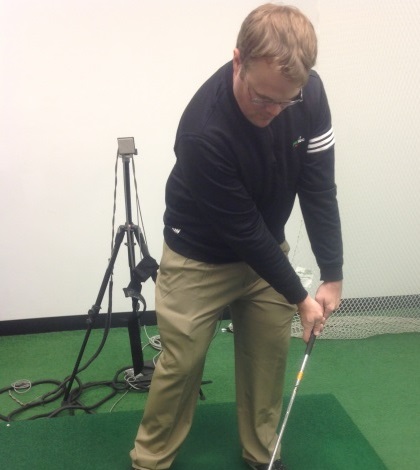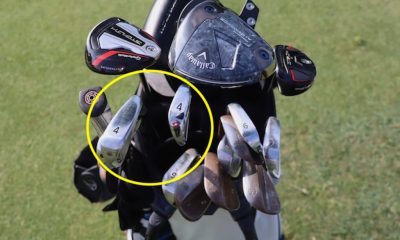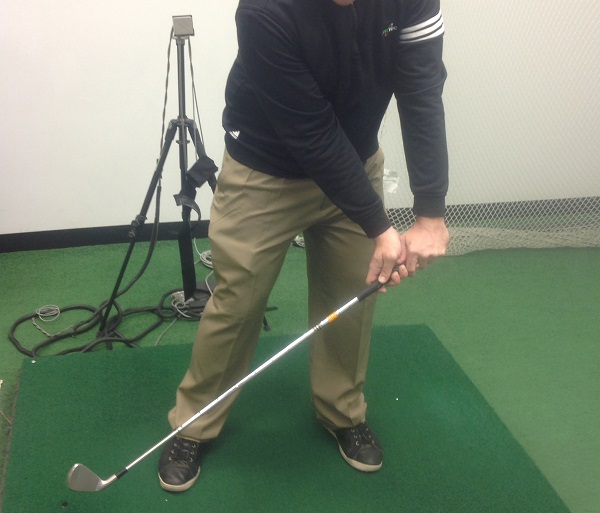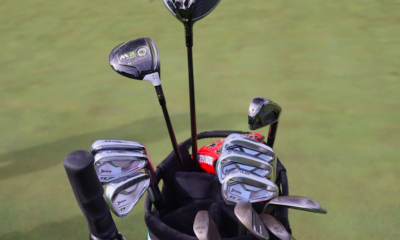Instruction
The role of the lead arm: Rotate, don’t pull for consistent contact

Many golfers who come to me for swing help (especially golfers who struggle with distance) have been told that by someone that they “release the club too soon.”
The theory behind the advice is not bad, because the hands need to stay in front of the club head to create the downward angle of attack at impact required for every club in the bag besides the driver. However, if the hands are not moving correctly during the downswing (which happens quite a bit when golfers tries to delay their release) golfers will have no choice but to release their hands early to square the club face.
Learning the correct way to bring the hands into the golf ball by rotating the lead arm makes it very difficult to release the club too early, which allows golfers to achieve a desired impact position with a square club face.
Many of my students describe the start of their downswing as a “pull” of the handle from the top. In theory, this move makes sense. If golfers pull the handle down (from the top of the backswing), then the club head will stay behind the hands. That should create the desired position of having the hands ahead of the club and the club shaft leaning forward at impact, right? Maybe, but most golfers who try to execute such a movement see inconsistent results.
The issue with trying to “pull” the club handle down in the downswing is that the club face remains open for too long. That means that golfers will need to get their hands involved late in the downswing to square the club face.
After pulling the club handle down, the club head is too open heading into impact. That means the hands must be used to square the club.
When I teach students the transition (the change from the backswing to the downswing), I emphasise the proper “release” of the club and the role the lead arm plays. At the start of the downswing, the lead arm has to begin to rotate as it moves down and around the body. By rotating the lead arm, the hands can still lead the club head into the golf ball, but the club face can also be squared without having to to get the hands too involved.
The lead arm has rotated so the lead wrist is pointing at the target. In the photo above, not only are our hands leading into impact, but the club face is square as well.
The easiest way to illustrate the feeling is to make swings with a wristwatch on your lead wrist. From the top of the swing, feel as if you are rotating the face of the watch down and through the golf ball so at impact the face points to the target with a flat leading wrist. When most golfers begin the downswing by pulling the handle of club down from the top of the swing, the watch points too far to the right (for a right-handed player).
Trying to not release the golf club too early is a great thought to have for consistent contact and longer shots, but it is important to learn the proper lead arm rotation to avoid having to make last-minute compensations at impact.
- LIKE200
- LEGIT27
- WOW19
- LOL13
- IDHT6
- FLOP12
- OB7
- SHANK33
Instruction
Clement: Laid-off or perfect fade? Across-the-line or perfect draw?

Some call the image on the left laid off, but if you are hitting a fade, this could be a perfect backswing for it! Same for across the line for a draw! Stop racking your brain with perceived mistakes and simply match backswing to shot shape!
- LIKE0
- LEGIT0
- WOW0
- LOL0
- IDHT0
- FLOP0
- OB0
- SHANK1
Instruction
The Wedge Guy: The easiest-to-learn golf basic

My golf learning began with this simple fact – if you don’t have a fundamentally sound hold on the golf club, it is practically impossible for your body to execute a fundamentally sound golf swing. I’m still a big believer that the golf swing is much easier to execute if you begin with the proper hold on the club.
As you might imagine, I come into contact with hundreds of golfers of all skill levels. And it is very rare to see a good player with a bad hold on the golf club. There are some exceptions, for sure, but they are very few and very far between, and they typically have beat so many balls with their poor grip that they’ve found a way to work around it.
The reality of biophysics is that the body moves only in certain ways – and the particulars of the way you hold the golf club can totally prevent a sound swing motion that allows the club to release properly through the impact zone. The wonderful thing is that anyone can learn how to put a fundamentally sound hold on the golf club, and you can practice it anywhere your hands are not otherwise engaged, like watching TV or just sitting and relaxing.
Whether you prefer an overlap, interlock or full-finger (not baseball!) grip on the club, the same fundamentals apply. Here are the major grip faults I see most often, in the order of the frequency:
Mis-aligned hands
By this I mean that the palms of the two hands are not parallel to each other. Too many golfers have a weak left hand and strong right, or vice versa. The easiest way to learn how to hold the club with your palms aligned properly is to grip a plain wooden ruler or yardstick. It forces the hands to align properly and shows you how that feels. If you grip and re-grip a yardstick several times, then grip a club, you’ll see that the learning curve is almost immediate.
The position of the grip in the upper/left hand
I also observe many golfers who have the butt of the grip too far into the heel pad of the upper hand (the left hand for right-handed players). It’s amazing how much easier it is to release the club through the ball if even 1/4-1/2″ of the butt is beyond the left heel pad. Try this yourself to see what I mean. Swing the club freely with just your left hand and notice the difference in its release from when you hold it at the end of the grip, versus gripping down even a half inch.
To help you really understand how this works, go to the range and hit shots with your five-iron gripped down a full inch to make the club the same length as your seven-iron. You will probably see an amazing shot shape difference, and likely not see as much distance loss as you would expect.
Too much lower (right) hand on the club
It seems like almost all golfers of 8-10 handicap or higher have the club too far into the palm of the lower hand, because that feels “good” if you are trying to control the path of the clubhead to the ball. But the golf swing is not an effort to hit at the ball – it is a swing of the club. The proper hold on the club has the grip underneath the pad at the base of the fingers. This will likely feel “weak” to you — like you cannot control the club like that. EXACTLY. You should not be trying to control the club with your lower/master hand.
Gripping too tightly
Nearly all golfers hold the club too tightly, which tenses up the forearms and prevents a proper release of the club through impact. In order for the club to move back and through properly, you must feel that the club is controlled by the last three fingers of the upper hand, and the middle two fingers of the lower hand. If you engage your thumbs and forefingers in “holding” the club, the result will almost always be a grip that is too tight. Try this for yourself. Hold the club in your upper hand only, and squeeze firmly with just the last three fingers, with the forefinger and thumb off the club entirely. You have good control, but your forearms are not tense. Then begin to squeeze down with your thumb and forefinger and observe the tensing of the entire forearm. This is the way we are made, so the key to preventing tenseness in the arms is to hold the club very lightly with the “pinchers” — the thumbs and forefingers.
So, those are what I believe are the four fundamentals of a good grip. Anyone can learn them in their home or office very quickly. There is no easier way to improve your ball striking consistency and add distance than giving more attention to the way you hold the golf club.
More from the Wedge Guy
- The Wedge Guy: Golf mastery begins with your wedge game
- The Wedge Guy: Why golf is 20 times harder than brain surgery
- The Wedge Guy: Musings on the golf ball rollback
- LIKE88
- LEGIT15
- WOW6
- LOL1
- IDHT0
- FLOP4
- OB1
- SHANK9
Instruction
Clement: Stop ripping off your swing with this drill!

Not the dreaded headcover under the armpit drill! As if your body is defective and can’t function by itself! Have you seen how incredible the human machine is with all the incredible feats of agility all kinds of athletes are accomplishing? You think your body is so defective (the good Lord is laughing his head off at you) that it needs a headcover tucked under the armpit so you can swing like T-Rex?
- LIKE0
- LEGIT3
- WOW2
- LOL0
- IDHT0
- FLOP0
- OB0
- SHANK2
-

 19th Hole2 weeks ago
19th Hole2 weeks agoLET pro gives detailed financial breakdown of first week on tour…and the net result may shock you
-

 19th Hole6 days ago
19th Hole6 days agoReport: LIV star turns down PGA Championship invite due to ‘personal commitments’
-

 19th Hole2 weeks ago
19th Hole2 weeks agoGary Player claims this is what ‘completely ruined’ Tiger Woods’ career
-

 Equipment5 days ago
Equipment5 days agoDetails on Justin Thomas’ driver switch at the Wells Fargo Championship
-

 Whats in the Bag2 weeks ago
Whats in the Bag2 weeks agoTeam McIlowry (Rory McIlroy, Shane Lowry) winning WITBs: 2024 Zurich Classic
-

 Whats in the Bag6 days ago
Whats in the Bag6 days agoKeegan Bradley WITB 2024 (May)
-

 Equipment2 weeks ago
Equipment2 weeks agoGolf fans left surprised by LIV’s choice of course for its 2024 individual championship event
-

 Equipment2 weeks ago
Equipment2 weeks agoWhy Wesley Bryan is playing two 4-irons this week























Dani
Sep 1, 2019 at 5:09 pm
I love golfwrx.com
I think it’s a great site!
Jeremy
Aug 19, 2016 at 11:05 am
Thanks for the article. It’s awesome to – as somebody like me whose swing drifts out of whack every couple of weeks with too little practice – feel the difference in the impact when contacting the ball before and after this correction.
It actually makes the swing feel easier, so lasts longer all day for consistent power, but the ball feels like butter more often and even sounds better. More of a clean click on contact rather than a struggly whap!. Ball flight too is way more piercing.
Josh McKinley
Oct 21, 2013 at 1:09 pm
Hey Scott,
Good article on the correct way to square the clubface through impact. Turning the watch is a good image to give to students to simplify this move. THanks!
Josh
blopar
Oct 10, 2013 at 8:54 am
go to http://www.rotarygolf.com and learn the biomechanics of a correct swing from “the lag doctor”
[email protected]
Oct 7, 2013 at 12:23 pm
Thanks for this article. My swing provides me feedback to when I’m pulling instead of rotating. Loss of distance and the shanks. Rotating the left arm through the ball has been the only reliable remedy for both..but I never really understood why. Thanks for the article.
regards……craig
TheLegend
Oct 6, 2013 at 11:01 am
+3 hdy. Hmmmmm I think we should get something strait. Your first move should be your shoulders turning followed by a great weight transfer, followed by your lead arm (so your left if your right handed)at the last 2 feet. You should be pulling with your left arm but only the last 2 feet. Your arms should only actually swing 2 feet at the bottom. Lag is created by the body not the arms. jack nicklaus and jhonny miller both pulled with the left arm but only at the last sec. The best players in the world use there big muscles to get the swing started and small muscles just to get a little bit of feel.
Josh McKinley
Oct 21, 2013 at 1:06 pm
Legend –
I agree that the big muscles should control the swing, but you are describing an incorrect sequence. The very first move from the top to start the downswing should be a weight transfer to the left side. This causes the hips to bump forward and begin turning toward the target. THEN the shoulders start to turn, following the hips, and finally the arms get PULLED down by the body. Scott is correct that, if you follow the proper sequence, you must rotate the left arm to square the clubface.
If you start the downswing by turning your shoulders first, you will get the club steep and, without some major compensating moves, have an outside – in swing path.
Joe Blow
Feb 10, 2019 at 6:12 am
Are you hot in a bikini?
Todd
Oct 6, 2013 at 9:46 am
Scott, Do you differentiate between arm rotation and wrist rotation?
Raymond Rapcavage
Oct 5, 2013 at 8:08 am
Scott,
Very good article by you and It is a relief that someone is talking IMPACT rather than droning on about making a perfect backswing. In our demo day clinics and my time with Jimmy Ballard we see 90% of golfers pulling down the handle, throwing their hands and arms, and rotating their forearms over each other to execute what they believe to be “releasing the club head”. When a golfer does this they miss in both directions and they rarely find the sweetspot of the clubface which is paramount to good ball striking .
Simply put you must lean the shaft forward at impact with a supinated or flat left wrist.
Consistant with your article is found on page 101 in Ben Hogan’s book “Five Lessons”… “AT IMPACT THE BACK OF THE LEFT HAND FACES TOWARDS THE TARGET ” and then on the following page there is an image of the left wrist supinating at impact and two frames after. If an amateur wants to know why the pros hit it so well then they should hone in on these two pages. Yes the backswing is important and other elements of the swing BUT you can do everything else perfect and IMPACT position wrong (cupping the left wrist) and you are doomed to being a bad ball striker.
Cheers,
Raymond Rapcavage
The Golf Swing Shirt Company
http://www.golfswingshirt.com
naflack
Oct 5, 2013 at 4:04 am
the old pull the handle bit…
i was its victim at one point as well.
the illustrations really convey the message.
Bill Shooter
Oct 4, 2013 at 12:10 pm
8000 lessons in 9 years is quite a bit!! I bet you really increased that lesson total at Royal Hawk CC.
Scott Hogan
Oct 4, 2013 at 7:05 pm
You know it, can I ask what you happen to shoot when you play golf Bill???
Mr Ted Cronk
Oct 4, 2013 at 10:55 am
Scott, I’ve been struggling mightily with the concept of late release, pulling the handle down from the top and executing my interpretation of creating ‘lag’. In fact, I’ve often wondered if I shouldn’t be doing just the opposite. When I just relax everything and allow the lead arm to rotate, I hit my best shots. Unfortunately, I didn’t trust that this was the way to swing the club or that I was getting the maximum distance I could achieve.
Now I look forward to the next session at the range and allowing the rotation to happen naturally. I should have trusted my inner voice and now, thanks to your article, I will.
I’ll let you know how it goes.
Ted